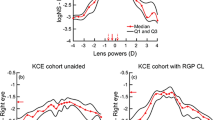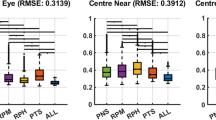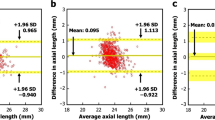Abstract
• Background: Image scaling on the Heidelberg Retina Tomograph (HRT) is based on an axial model of ametropia. In the longitudinal follow-up of patients, refractive changes in ametropia may occur; the HRT interprets such change as being axial in origin. This results in an apparent alteration in the size of fundus features with time and in reduced sensitivity of the instrument to subtle changes relating to disease progression. The aim of this study was to determine the effect of changing HRT focus settings on the absolute scaling of topography images. • Methods: Seven image series were acquired of the optic nerve head of a single emmetropic eye at each of a range of panel focus settings under three conditions: (A) emmetropia, (B) trial lens-induced ametropia, (C) contact lens-induced ametropia. A masked observer measured the separation between two defined retinal vascular bifurcations for each topography image. bb Results: The measured distance decreased with a positive shift in focus. There was a significant difference in distance with change in focus setting for all conditions (A P<0.008, B and C P<0.0001). Over equivalent focus ranges, data from the three groups were not significantly different, lying within the 95% confidence limits at each setting. The mean standard deviation for the distance measure was 10 μm. • Conclusion: Adjustment in focus settings to compensate for refractive change in eyes of stable axial length and keratometry induces a change in the topography measures using the HRT. It is recommended that, for the detection of subtle change over time, refractive changes are corrected without a change in the panel focus setting.
Similar content being viewed by others
References
Arnold JV, Gates JWC, Taylor KM (1993) Possible errors in the measurement of retinal lesions. Invest Ophthalmol Vis Sci 34:2576–2580
Bartz-Schmidt KU, Weber J, Heimann K (1993) Optic disc size calculations using Littmann's formula differs from in-vivo measures of the optic disc during vitrectomy. Invest Ophthalmol Vis Sci 33 [Suppl]:3979
Bennett AG, Rabbetts RB (1990) Clinical visual optics, 2nd edn. Butterworth-Heinemann, Oxford, pp 216–228
Blaker JW (1980) Toward an adaptive model of the human eye. J Opt Soc Am 70:220
Filliben JJ (1975) The probability plot coefficient test for normality. Technometrics 17: 111–117
Navarro R, Santamaria J, Bescos J (1985) Accommodation dependent model for the human eye. J Opt Soc Am [A] 2:1273–1281
Pach J, Pennell DO, Romano PE (1989) Optic disc photogrammetry: magnification factors for eye position, centration, and ametropias, refractive and axial; and their application in the diagnosis of the optic nerve hypoplasia. Ann Ophthalmol 21:454–462
Spencer AF, Sadiq SA, Pawson P, Vernon SA (1995) Vertical optic disc diameter: discrepancy between planimetric and SLO measurements. Invest Ophthalmol Vis Sci 36:796–803
Author information
Authors and Affiliations
Rights and permissions
About this article
Cite this article
Hosking, S.L., Flanagan, J.G. Prospective study design for the Heidelberg retina tomograph: the effect of change in focus setting. Graefe's Arch Clin Exp Ophthalmol 234, 306–310 (1996). https://doi.org/10.1007/BF00220705
Received:
Revised:
Accepted:
Issue Date:
DOI: https://doi.org/10.1007/BF00220705




